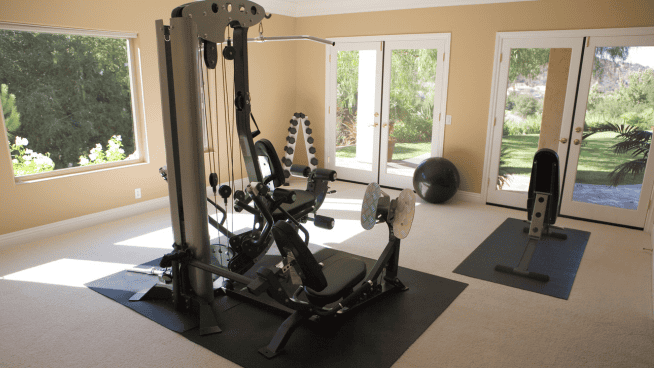Add 6 Inches to Your Vertical Jump in 3 Weeks With This Advanced Plyo Workout
Eight years ago, I came across two vertical jump training methods, which, when combined, changed the way I thought about training explosive athletic power. The combination of the ideals of the two systems facilitated explosive gains above and beyond anything I had seen in the past, even a Depth Jump training program that I myself had used to gain 5 solid inches on one- and two-leg vertical jumps in two months.
What is this program, and what were its foundations? The program was inspired by:
- Professor Yuri Verkhoshansky’s (the father of plyometrics) recommended workout for improving vertical jump ability, which I had seen on his training forum.
- Nelio Moura, a Brazilian jumps coach and one of the best in the world in his craft, demonstrated that in high level athletes, shorter training cycles (2 weeks on, 1 week off) were most effective.
I took much of Dr. Verkhoshansky’s program, which features two days of plyometric training and two of weightlifting, and cut it down to a “2 weeks on, 1 week deload” template.
RELATED: 3 Tips to Instantly Increase your Vertical Jump
What I found was that after months of stagnation, my vertical jump and explosive power improved markedly. My running jump went up a full 6 inches in three weeks, and I quickly found that many others were achieving similar results. I still get emails, eight years later, from athletes who are getting big gains off this type of program, which I made available.
The key to effective training is to continually stimulate the body beyond the point it was at originally. There comes a time, particularly with jumping, where a deeper access to the muscle motor pool must be granted. In many cases, this can only be achieved by doing plyometric and weight training on consecutive days, since shortening the rest period between strength work and a plyometric workout changes the demands of the internal load on the muscles, while offering interesting potentiation options for those who respond well to it.
This type of program shouldn’t be used as a “standalone” for an entire season. But when used for a few weeks or months during the off-season, it can prove devastatingly effective.
RELATED: How Does Your Vertical Jump Measure Up?
The original version of this workout was published eight years ago on my website, www.just-fly-sports.com, and it is a continual reminder of how effective a workout with no flashy bells or whistles can be. So often we are tempted to over-fluff workouts with pieces that don’t contribute to the end result, or to put in volumes of work that become counterproductive.
I have modified this workout only slightly from the original, even though my library of training schemes has multiplied many times over in that time frame.
The volume of Bounding is adjustable based on training age. To do the advanced volume, I suggest having had at least 3-4 years of consistent plyometric training, physical maturity, and a propensity towards elastic work.
RELATED: 3 Box Jump Mistakes That Can Ruin Your Vertical Jump
Here is the program:
Week 1:
Monday: Weights
- Dynamic Warm-Up of choice: 20-30 minutes
- Power Clean from the floor: 1×5 @ 50%, 1×5 @ 55%, 1×4 @ 65%, 1×3 @75%, 1×3@70%
- Barbell Box Step-Up on 10-12″ box: 2-3×6 @ 60-70%
- Barbell Calf Raise or Single Leg Barefoot Calf Raise: 3×10
- Glute Ham Raise: 3×5
- Jump Squats with minimal knee bend and ground time: 2×15, 45 lb
- 3-4 x 60m sprint strides at 70% or 3-4 x 25-meter sprint dribbles
- Recovery
Tuesday: Plyometrics
- Dynamic warmup: 20-30 minutes
- Bounding Series: 1′ between sets (1 round for intermediates, 2 rounds for advanced)
- Left-Right-Left-Right x 30m
- Left-Left-Right-Right x 30m
- Left-Left-Left-Right-Right-Right x 30m
- Left Leg Only x 30m
- Right Leg Only x 30m
- Alternate Leg Bounding: 50m x 2
- Hurdle Hops: 6 × 4 over higher hurdles
- Jump Rope 3×100, or Light Skipping and Side Shuffling, 400m
Wednesday: Active Recovery
Go for a 1-2 mile slow jog or play a sport for 30-45 minutes at moderate intensity. Quick reaction sports such as raquetball are best, because they stimulate the visual and neural pathways without greatly taxing muscles and joints.
Thursday: Weights
- Dynamic Warm-Up: 20-30 minutes
- Snatch or Jerk/Push Press: 1×5 @ 55%, 1×4 @ 65% 1×3 @ 75 1×3 @ 80%
- Barbell Half Squat or Barbell 2/3 Squat: 3×6 @ 60-75%
- Single Leg Calf Raise: 2×10 with added 20-50 lbs weight
- Nordic Hamstring Curl: 2×5
- Speed Half Squats: 3×5 with bodyweight equivalent on barbell
- 3-4 x 60m sprint strides at 70% or 3-4 x 25m sprint dribbles
Friday: Plyometrics
- Bounding with 8-16-lb weight vest or up a light incline (1 round for intermediate, 2 for advanced)
- LRLRLR x 25m
- LLRR x 25m
- LLLRRR x 25m
- LLLL x 25m
- RRRR x 25m
- LRLRLR x 40m x 2
- Hurdle Hops: 5×5 (lower hurdles) (make sure minimal ground contact time is attained)
- Jump Roping: 3×100 or jogging/skipping for 400m
Week 2: Slightly higher intensity, lower volume
Monday: Weights
- Dynamic Warm-Up: 20-30 minutes
- Power Clean from the floor: 1×5 @ 55%, 1×5 @ 65%, 1×3 @75%, 1×2@83%
- 10-12″ Barbell Box Step-Up: 2×6, @ 70%
- Barbell Calf Raise: 2×10, heavy
- Jump Squats with minimal knee bend and ground time: 2×12, 55-65lb
- 3-4 x 60m sprint strides at 70% or 3-4 x 25m sprint dribbles
- Recovery
Tuesday: Plyometrics
- Dynamic Warm-Up: 20-30 minutes
- Bounding with full recovery between sets (1 set for intermediate, 2 for advanced)
- LRLRLR x 30m
- LLRR x 30m
- LLLRRR x 30m
- LLLL x 30m
- RRRR x 30m
- LRLRLR x 50m x 2
- Hurdle Hops: 5×4 over higher hurdles
- Jump Rope: 3×50
Wednesday: Active Recovery
Go for a 1-2 mile slow jog or play a sport for 30-45 minutes at moderate intensity.
Thursday: Weights
- Dynamic Warm-Up: 20-30 minutes
- Snatch or Jerk/Push Press: 4,3,2 moderate/heavy weight (80-85% 1RM)
- 1/2 Squat: 2×6 65-80%
- Single Leg Calf Raise: 2×10 with weight
- Jump Squats: 2×15, 55-65lb
Friday: Plyometrics
- Dynamic Warm-Up: 20-30 minutes
- Bounding with 8-16-lb weight vest or up slight grade (1 set for intermediate, 2 for advanced)
- LRLRLR x 25m
- LLRR x 25m
- LLLRRR x 25m
- LLLL x 25m
- RRRR x 25m
- LRLRLR x 40m x 1
- Hurdle Hops: 5×5 (lower hurdles) (make sure minimal ground contact time is attained)
- Jump Rope: 3×50.
Week 3: Deloading
Monday:
- Dynamic Warm-Up: 10-20 minutes
- 3x30m Low Skips
- 3x30m High Skips
- 3x30m Skip for Distance
Tuesday:
- Go for a 1-2 mile slow jog or play a sport for 30-45 minutes at moderate intensity.
Wednesday:
- Dynamic Warm-Up: 10-20 minutes
- Half Squat: 2×4
- Cleans light: 2×4
- Snatch light: 2×10
Thursday:
- Go for a 1-2 mile slow jog or play a sport for 30-45 minutes at moderate intensity.
Friday:
- Dynamic Warm-Up: 10-20 minutes
- 3x100m Accelerations
- Test Single and Double Leg Jumping
- Jump Rope: 4×50
This three-week training cycle can be repeated multiple times, I have found that athletes can often tolerate 3-4 rounds of this before they hit a ceiling. This training is generally made better by doing it on a foundation of 6-8 weeks of sustained training, where athletes work 3 neuromuscular days a week, and 3 metabolic and general strength days a week. This way, athletes get a solid foundation of neuromuscular effort, and can then more deeply access the motor pool for a planned segment of intensive plyometric training.
RECOMMENDED FOR YOU
Add 6 Inches to Your Vertical Jump in 3 Weeks With This Advanced Plyo Workout
Eight years ago, I came across two vertical jump training methods, which, when combined, changed the way I thought about training explosive athletic power. The combination of the ideals of the two systems facilitated explosive gains above and beyond anything I had seen in the past, even a Depth Jump training program that I myself had used to gain 5 solid inches on one- and two-leg vertical jumps in two months.
What is this program, and what were its foundations? The program was inspired by:
- Professor Yuri Verkhoshansky’s (the father of plyometrics) recommended workout for improving vertical jump ability, which I had seen on his training forum.
- Nelio Moura, a Brazilian jumps coach and one of the best in the world in his craft, demonstrated that in high level athletes, shorter training cycles (2 weeks on, 1 week off) were most effective.
I took much of Dr. Verkhoshansky’s program, which features two days of plyometric training and two of weightlifting, and cut it down to a “2 weeks on, 1 week deload” template.
RELATED: 3 Tips to Instantly Increase your Vertical Jump
What I found was that after months of stagnation, my vertical jump and explosive power improved markedly. My running jump went up a full 6 inches in three weeks, and I quickly found that many others were achieving similar results. I still get emails, eight years later, from athletes who are getting big gains off this type of program, which I made available.
The key to effective training is to continually stimulate the body beyond the point it was at originally. There comes a time, particularly with jumping, where a deeper access to the muscle motor pool must be granted. In many cases, this can only be achieved by doing plyometric and weight training on consecutive days, since shortening the rest period between strength work and a plyometric workout changes the demands of the internal load on the muscles, while offering interesting potentiation options for those who respond well to it.
This type of program shouldn’t be used as a “standalone” for an entire season. But when used for a few weeks or months during the off-season, it can prove devastatingly effective.
RELATED: How Does Your Vertical Jump Measure Up?
The original version of this workout was published eight years ago on my website, www.just-fly-sports.com, and it is a continual reminder of how effective a workout with no flashy bells or whistles can be. So often we are tempted to over-fluff workouts with pieces that don’t contribute to the end result, or to put in volumes of work that become counterproductive.
I have modified this workout only slightly from the original, even though my library of training schemes has multiplied many times over in that time frame.
The volume of Bounding is adjustable based on training age. To do the advanced volume, I suggest having had at least 3-4 years of consistent plyometric training, physical maturity, and a propensity towards elastic work.
RELATED: 3 Box Jump Mistakes That Can Ruin Your Vertical Jump
Here is the program:
Week 1:
Monday: Weights
- Dynamic Warm-Up of choice: 20-30 minutes
- Power Clean from the floor: 1×5 @ 50%, 1×5 @ 55%, 1×4 @ 65%, 1×3 @75%, 1×3@70%
- Barbell Box Step-Up on 10-12″ box: 2-3×6 @ 60-70%
- Barbell Calf Raise or Single Leg Barefoot Calf Raise: 3×10
- Glute Ham Raise: 3×5
- Jump Squats with minimal knee bend and ground time: 2×15, 45 lb
- 3-4 x 60m sprint strides at 70% or 3-4 x 25-meter sprint dribbles
- Recovery
Tuesday: Plyometrics
- Dynamic warmup: 20-30 minutes
- Bounding Series: 1′ between sets (1 round for intermediates, 2 rounds for advanced)
- Left-Right-Left-Right x 30m
- Left-Left-Right-Right x 30m
- Left-Left-Left-Right-Right-Right x 30m
- Left Leg Only x 30m
- Right Leg Only x 30m
- Alternate Leg Bounding: 50m x 2
- Hurdle Hops: 6 × 4 over higher hurdles
- Jump Rope 3×100, or Light Skipping and Side Shuffling, 400m
Wednesday: Active Recovery
Go for a 1-2 mile slow jog or play a sport for 30-45 minutes at moderate intensity. Quick reaction sports such as raquetball are best, because they stimulate the visual and neural pathways without greatly taxing muscles and joints.
Thursday: Weights
- Dynamic Warm-Up: 20-30 minutes
- Snatch or Jerk/Push Press: 1×5 @ 55%, 1×4 @ 65% 1×3 @ 75 1×3 @ 80%
- Barbell Half Squat or Barbell 2/3 Squat: 3×6 @ 60-75%
- Single Leg Calf Raise: 2×10 with added 20-50 lbs weight
- Nordic Hamstring Curl: 2×5
- Speed Half Squats: 3×5 with bodyweight equivalent on barbell
- 3-4 x 60m sprint strides at 70% or 3-4 x 25m sprint dribbles
Friday: Plyometrics
- Bounding with 8-16-lb weight vest or up a light incline (1 round for intermediate, 2 for advanced)
- LRLRLR x 25m
- LLRR x 25m
- LLLRRR x 25m
- LLLL x 25m
- RRRR x 25m
- LRLRLR x 40m x 2
- Hurdle Hops: 5×5 (lower hurdles) (make sure minimal ground contact time is attained)
- Jump Roping: 3×100 or jogging/skipping for 400m
Week 2: Slightly higher intensity, lower volume
Monday: Weights
- Dynamic Warm-Up: 20-30 minutes
- Power Clean from the floor: 1×5 @ 55%, 1×5 @ 65%, 1×3 @75%, 1×2@83%
- 10-12″ Barbell Box Step-Up: 2×6, @ 70%
- Barbell Calf Raise: 2×10, heavy
- Jump Squats with minimal knee bend and ground time: 2×12, 55-65lb
- 3-4 x 60m sprint strides at 70% or 3-4 x 25m sprint dribbles
- Recovery
Tuesday: Plyometrics
- Dynamic Warm-Up: 20-30 minutes
- Bounding with full recovery between sets (1 set for intermediate, 2 for advanced)
- LRLRLR x 30m
- LLRR x 30m
- LLLRRR x 30m
- LLLL x 30m
- RRRR x 30m
- LRLRLR x 50m x 2
- Hurdle Hops: 5×4 over higher hurdles
- Jump Rope: 3×50
Wednesday: Active Recovery
Go for a 1-2 mile slow jog or play a sport for 30-45 minutes at moderate intensity.
Thursday: Weights
- Dynamic Warm-Up: 20-30 minutes
- Snatch or Jerk/Push Press: 4,3,2 moderate/heavy weight (80-85% 1RM)
- 1/2 Squat: 2×6 65-80%
- Single Leg Calf Raise: 2×10 with weight
- Jump Squats: 2×15, 55-65lb
Friday: Plyometrics
- Dynamic Warm-Up: 20-30 minutes
- Bounding with 8-16-lb weight vest or up slight grade (1 set for intermediate, 2 for advanced)
- LRLRLR x 25m
- LLRR x 25m
- LLLRRR x 25m
- LLLL x 25m
- RRRR x 25m
- LRLRLR x 40m x 1
- Hurdle Hops: 5×5 (lower hurdles) (make sure minimal ground contact time is attained)
- Jump Rope: 3×50.
Week 3: Deloading
Monday:
- Dynamic Warm-Up: 10-20 minutes
- 3x30m Low Skips
- 3x30m High Skips
- 3x30m Skip for Distance
Tuesday:
- Go for a 1-2 mile slow jog or play a sport for 30-45 minutes at moderate intensity.
Wednesday:
- Dynamic Warm-Up: 10-20 minutes
- Half Squat: 2×4
- Cleans light: 2×4
- Snatch light: 2×10
Thursday:
- Go for a 1-2 mile slow jog or play a sport for 30-45 minutes at moderate intensity.
Friday:
- Dynamic Warm-Up: 10-20 minutes
- 3x100m Accelerations
- Test Single and Double Leg Jumping
- Jump Rope: 4×50
This three-week training cycle can be repeated multiple times, I have found that athletes can often tolerate 3-4 rounds of this before they hit a ceiling. This training is generally made better by doing it on a foundation of 6-8 weeks of sustained training, where athletes work 3 neuromuscular days a week, and 3 metabolic and general strength days a week. This way, athletes get a solid foundation of neuromuscular effort, and can then more deeply access the motor pool for a planned segment of intensive plyometric training.










